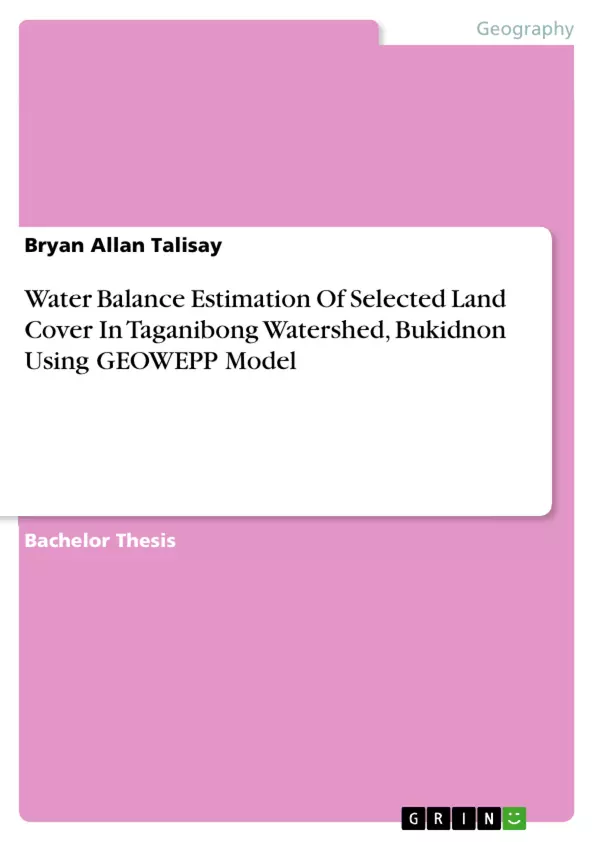The Geospatial Water Erosion Prediction Project (GeoWEPP v10.2) was tested using data from field survey in three study site within Taganibong Watershed, Bukidnon. This field survey data such as waypoints and soil data was processed and edited through ArcGIS software to prepare for model simulation. Weather information were collected using Automatic Weather Station on an hourly basis at the study site. Climate data was created using Breakpoint Climate Data Generator (BPCDG) which allows direct use of observed storm and other daily standard climate datasets.
Model simulation was applied in three land cover to evaluate their abilities in reducing runoff and their effects on other water balance parameters. For the study area, the bamboo area with undisturbed harvesting practices has more effective way in reducing surface runoff based on the results of model simulation. On the other hand, the cultivated area (corn) produce highest surface runoff due to the exposure of soil after harvesting period.
Statistical analysis was applied to determine the effects of different land cover to the amount of water balance given the amount of rainfall in monthly basis. Magnitude of rainfall as the primary input to water balance has a huge effects in return to hydrologic processes (percolation, soil water, subsurface lateral flow, etc). This study provides a theoretical basis and technical support for land use zoning, policy implementation, soil and water conservation in upland watersheds.
Inhaltsverzeichnis (Table of Contents)
- Background
- Methodology
- Study Area
- Data Collection of Parameter Files
- Climate Data Collection
- Land Cover and Plant Parameters Data Collection
- Slope Data Collection
- Soil Data Collection
- Data Preparation and Processing of Database File
- Digital Elevation Model
- Land cover and Soil Map Layers
- Climate Database File
- Landuse/Management Database File
- Soil Database File
- Slope Database File
- Model Simulation Run
- Statistical Analysis
- Results and Discussion
- GIS Layers
- Water balance simulation
- Statistical Analysis
- Conclusion
Zielsetzung und Themenschwerpunkte (Objectives and Key Themes)
This research study aims to evaluate the effectiveness of different land cover types within Taganibong Watershed in Bukidnon, Philippines, in reducing surface runoff and their impact on water balance parameters using the GeoWEPP model (v10.2). The study focuses on three specific land cover types: bamboo, cultivated (corn), and fallow areas.
- Water balance estimation in different land cover types
- Assessment of surface runoff reduction effectiveness
- Impact of land cover on water balance parameters
- Application of GeoWEPP model for watershed management
- Statistical analysis of water balance data
Zusammenfassung der Kapitel (Chapter Summaries)
The "Background" chapter provides a comprehensive overview of watershed management, highlighting the importance of maintaining water quality and quantity for both human needs and wildlife habitats. It emphasizes the challenges of watershed degradation and the need for effective rehabilitation efforts. The chapter also introduces the Water Erosion Prediction Project (WEPP) model and its application in estimating soil erosion, water balance, and runoff.
The "Methodology" chapter details the research approach, including the study area selection, data collection methods, and model simulation procedures. It describes the specific land cover types investigated (bamboo, cultivated, and fallow areas), as well as the data sources and processing techniques used. The chapter also outlines the statistical analysis methods employed to evaluate the impact of land cover on water balance.
The "Results and Discussion" chapter presents the findings of the GeoWEPP model simulations and statistical analysis. It examines the water balance parameters for each land cover type, focusing on surface runoff and its relationship to rainfall and other factors. The chapter also discusses the implications of the results for watershed management practices.
Schlüsselwörter (Keywords)
The study focuses on the application of GeoWEPP model, water balance estimation, land cover analysis, surface runoff reduction, watershed management, and statistical analysis in the context of Taganibong Watershed in Bukidnon, Philippines. The research investigates the impact of different land cover types, particularly bamboo, cultivated, and fallow areas, on water balance parameters.
- Quote paper
- Forester Bryan Allan Talisay (Author), 2015, Water Balance Estimation Of Selected Land Cover In Taganibong Watershed, Bukidnon Using GEOWEPP Model, Munich, GRIN Verlag, https://www.grin.com/document/342254



